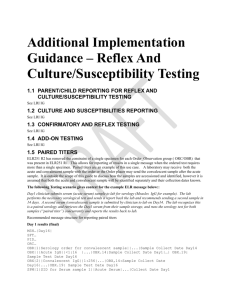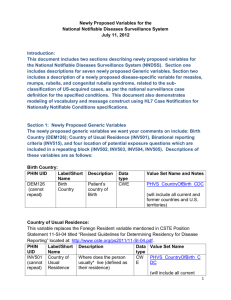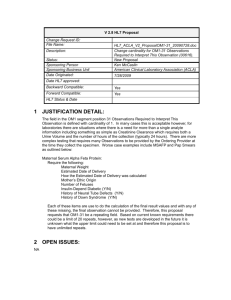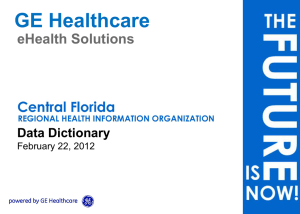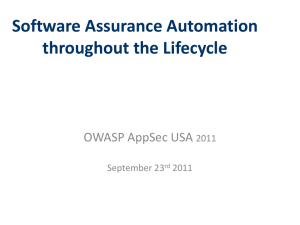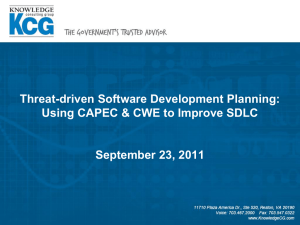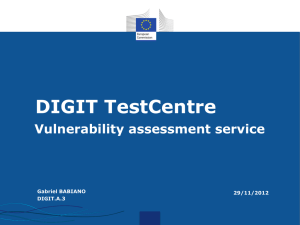Additional Implementation Guidance
advertisement
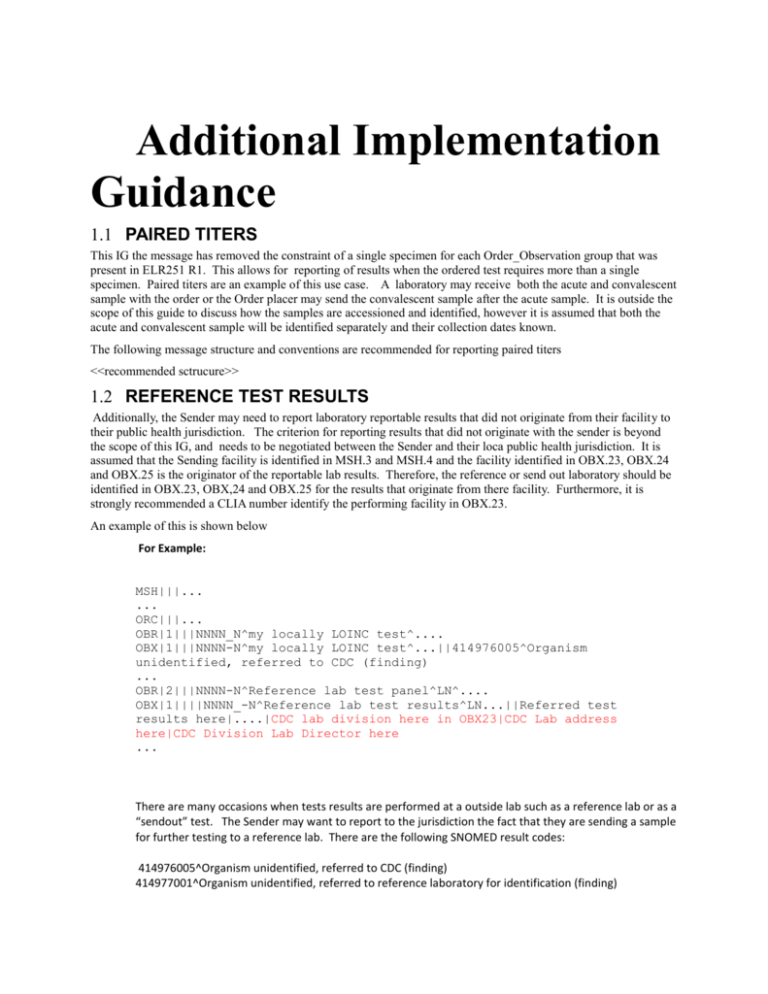
Additional Implementation Guidance 1.1 PAIRED TITERS This IG the message has removed the constraint of a single specimen for each Order_Observation group that was present in ELR251 R1. This allows for reporting of results when the ordered test requires more than a single specimen. Paired titers are an example of this use case. A laboratory may receive both the acute and convalescent sample with the order or the Order placer may send the convalescent sample after the acute sample. It is outside the scope of this guide to discuss how the samples are accessioned and identified, however it is assumed that both the acute and convalescent sample will be identified separately and their collection dates known. The following message structure and conventions are recommended for reporting paired titers <<recommended sctrucure>> 1.2 REFERENCE TEST RESULTS Additionally, the Sender may need to report laboratory reportable results that did not originate from their facility to their public health jurisdiction. The criterion for reporting results that did not originate with the sender is beyond the scope of this IG, and needs to be negotiated between the Sender and their loca public health jurisdiction. It is assumed that the Sending facility is identified in MSH.3 and MSH.4 and the facility identified in OBX.23, OBX.24 and OBX.25 is the originator of the reportable lab results. Therefore, the reference or send out laboratory should be identified in OBX.23, OBX,24 and OBX.25 for the results that originate from there facility. Furthermore, it is strongly recommended a CLIA number identify the performing facility in OBX.23. An example of this is shown below For Example: MSH|||... ... ORC|||... OBR|1|||NNNN_N^my locally LOINC test^.... OBX|1|||NNNN-N^my locally LOINC test^...||414976005^Organism unidentified, referred to CDC (finding) ... OBR|2|||NNNN-N^Reference lab test panel^LN^.... OBX|1||||NNNN_-N^Reference lab test results^LN...||Referred test results here|....|CDC lab division here in OBX23|CDC Lab address here|CDC Division Lab Director here ... There are many occasions when tests results are performed at a outside lab such as a reference lab or as a “sendout” test. The Sender may want to report to the jurisdiction the fact that they are sending a sample for further testing to a reference lab. There are the following SNOMED result codes: 414976005^Organism unidentified, referred to CDC (finding) 414977001^Organism unidentified, referred to reference laboratory for identification (finding) Example: OBX|1|ST|20951-0^Salmonella sp serotype [Identifier] in Isolate by Agglutination^LN...|| 41497600^Organism unidentified, referred to CDC (finding) ^SCT …|||... NTE|1|L|Sending to CDC for further Characterization… Concept codes for “Referred to reference laboratory” and “Referred to CDC” submitted to SNOMED and are pending. Example: OBX||Influenza test|1|inconclusive OBX||Influenza test|2|<new SNOMED>^Referred to reference laboratory… In these cases, it is recommended ,an NTE segment follow the OBX which comments on the referral. This IG shall be silent on whether the results should be partial until the referred results came back. 1.3 WHEN NO STANDARD CODING EXISTS FOR CWE DATATYPES CWE_RE If you have a local code but no valid standard code exists then populate the first triplet with the local code. Example: SPM|1||||NW^Nasal Wash^L|… In some instances the sender may have an uncoded (text only ) element or a free text entry. If neither a valid standard nor a local code exists then populate CWE_RE.9 ,Original text, with the data Example: SPM|1||||^^^^^^^^Nasal Wash|… CWE_R for coded results in OBR.4 and OBX.3 If you have a local code but no valid LOINC exist then populate the first triplet with the local code. Example: OBR|1|||1234^Syphilis Panel^L|||… In some instances the sender may have an uncoded (text only ) element or a free text entry. If you have neither a standard nor a local code then use the CWE Status value NAV(Not available ) and populate the CWE_R.9 ( original text) with the text entry. Example: OBR|1|||NAV^Not Available^HL70353^^^^^Syphilis Panel|||… CWE_RO For coded results in OBX.5: OBX.5 CWE data type requires the first, third element and ninth elements to be populated (CWE.1 = R, CWE.3, CWE.9 =R) , Two methods are described below when a standard SNOMED CT concept ID is not available.. The choice of which method will work requires negotiation between the Sender and the local public health jurisdiction. Method 1: Use parent SNOMED code, i.e. move up the vocabulary hierarchy tree to the next level to code (e.g. Serovar to Subspecies) and populate original text OBX.5.9 for results– assume same thing as print out on report. However the local code and original text should represent current level of knowledge. Example: OBX|1|CWE|20951-0^Salmonella sp serotype [Identifier] in Isolate by Agglutination^…||398508004^Salmonella enterica subsp. Enterica^SCT^167^Salmonella subspecies I:Rough:i:1,2^L^07/31/2011^1.2^Salmonella subspecies I:Rough:i:1,2||… Method 2: Use only local code and wait for Standard code AND You should always populate original text OBX.5.9 for results– assume same thing as print out on report. Example: OBX|1|CWE|20951-0^Salmonella sp serotype [Identifier] in Isolate by Agglutination^…||167^Salmonella subspecies I:Rough:i:1,2^L^167^Salmonella subspecies I:Rough:i:1,2^L^1.2^1.2^Salmonella subspecies I:Rough:i:1,2||… 1.3.1.1 Options when reporting text only results in OBX.5 If neither a valid standard nor local code exists then: OPTION 1) change the “Value type” in OBX.2 to ST (String) or TX (Text) and populate the field with a text only entry. Example: OBX|1|ST|20951-0^Salmonella sp serotype [Identifier] in Isolate by Agglutination^…||Salmonella subspecies I:Rough:i:1,2||… OPTION 2) Use high level SNOMED concept code, “441742003^Evaluation finding (finding)” as a default value for “Code Unavailable” CWE, and populate CWE.9 with the text only data. This may be useful for error trapping if lacking a standard code from sender. Example: OBX|1|CWE|20951-0^Salmonella sp serotype [Identifier] in Isolate by Agglutination^…||441742003^Evaluation finding (finding)^SCT^^^^^^Salmonella subspecies I:Rough:i:1,2 1.4 HOW TO CREATE AN IMPLEMENTABLE PROFILE FROM THIS CONSTRAINABLE PROFILE The purpose of this section it to provide guidance to public health agency in developing a conformant implementable profile that meets the needs for their jurisdiction. It is important to realize the Sender may message ELR messages to multiple jurisdictions , therefore, in order to maintain this interoperability, the fully implementable profile created by one jurisdiction places must still preserve the underlying base profile conformance. If the underlying conformance is not taken into consideration then the same message may cause an error if sent to a neighboring jurisdictions. Please refer to the v 2.8 CH C.B ballot document for a full discussion of conformance , constrainable profiles and implementable profiles Ground rules for creating a fully implementable profile and maintaining interoperability across jurisdictions: The behavior of the Receiving applications must IGNORE all elements it does not expect including those elements with Usage X and O. Redefining Usage for elements: Listed below are the allowable constraints for usage types to maintain conformance with this IG: RR RE R, RE C(R//b) R, C(R/b) ( b follow same rules) C(RE//b) R,RE, C(R/b), C(RE,/b) ( b follow same rules) O R, RE, C(A/B), X XX Cardinality: Usage Rules above outlines the cardinalities allowed for various usage constraints. Refer to the cardinality table from the V2.7.1 Section 2.B.7.4 base standard. Additionally, for the purposes of creating an implementable profile from this guide, consider the cardinalities as the minimum allowed. If the receiver is expecting fewer repetitions of an element that the bound set by the implementable profile, the burden is on the receiver to determine which repetitions it is interested in receiving. Length: For the purposes of creating an implementable profile from this guide, the upper limit of allowed length published above will be considered the conformance length. Truncation characters ( #,=) can be assigned a to all lengths not already defined. Datatypes: the datatypes cannot be changed. Vocabulary: The vocabulary can be further constrained and still maintain broad interoperability. If on the other hand, a jurisdiction may needs to locally extend the vocabulary to meet their requirements, the local vocabulary may not be compatible with neighboring jurisdictions and the sender should be made aware of this. 1.5 EPIDEMIOLOGICAL IMPORTANT INFORMATION FROM ASK ON ORDER ENTRY RESPONSES There are several common core data elements that have been identified as important data elements1 for Public Health laboratory reporting that do not have a supported field in the ELR252 message. This data may be available to the sending laboratory as a result of Ask at Order Entry (AOE) responses to the laboratory that provides critical information for the calculation or interpretation of some lab results or to satisfy state and federal health agency mandated information gathering requirements, e.g., for blood lead testing. Not every order will have the need for AOE questions and associated observations. Examples of the type of information gathered from a patient include employment information, pregnancy status, the date of the last menstrual period, mother’s age, and questions about family and personal history. AOE responses can take several formats, including but not limited to: • Yes/No (and coded) to answer questions like “Is this your first pregnancy?” • A code drawn from a value set to provide a coded response to “What ethnicity do you consider yourself part of?” • A number with units for the mother’s age • A date format for the patient’s last menstrual period. There are several potential approaches to including this information when available, but for this IG, they are messaged as an observation in an OBX segment The observations (OBX) segment may follow an Order (OBR) or the Specimen segment (SPM). The table below lists several of these data element and how to report them as an observation as well as the context in which the element would be expressed in the message. Please note adoption of this value set is voluntary and based upon the individual public health jurisdiction’s requirements. Context OBR-4 for Order_Observation group for Epidemiologically important information for public health reporting panel. 1 Table N-NN. Epidemiologically Important Questions OBX .2 OBX.3 OBX.5 OBX.6 Comments Obs erv atio n Observation Typ Identifier: Observation e LOINC Value Set Units This is provided an an option to message Epidemiologically Important Questions as a 68991unique Order_Observation 9^Epidemiologically Group. important information Note: The Filler Order number for public health (OBR.3) must be unique in the NA reporting panel^LN NA NA message. Standards & Interoperability Framework (S&I) Public Health Reporting Initiative (PHRI) Data Harmonization Profile Version 1.5. PHRI has developed this data harmonization profile to reflect the common core data elements for public health reporting, including harmonized data element names, descriptions, formats, and value sets. Currently this document is being balloted within the S&I PHRI work group and is available at: http://wiki.siframework.org/file/view/DRAFT_DataHarmonizationProfile_V1%205.docx/378300894/DRAFT_DataHarmonization Profile_V1%205.docx The age of patient at time of specimen collection. Date when sign and symptoms of condition first appeared. SN,N M 35659-2^Age at specimen collection^LN or 21612-7^Reported Patient Age^LN Numeric UCUM Units, for example: a^years^UC UM d^days^UC UM h^hours^UC UM TS_3 11368-8^Illness or injury onset date and time^LN YYYY[MM[DD[H H[MM[SS[.S[S[S[ S]]]]]]]]][+/-ZZZZ] [empty] Fasting Status of patient at time of specimen collection. CWE 49541-6^Fasting status [Presence] Reported^LN Pregnancy status of (female) patient at time of specimen collection. CWE 11449-6^Pregnancy status^LN HL7 TABLE 0916 CHOICEe: 1) HL7 Table 0532 ***Table 0532 expands on the original Yes/no indicator table by including "flavors of null". It is intended to be applied to fields where the response is not limited to "yes" or "no". 2) OR consider SNOMED Codes SNOMED value Set: 261665006^Unk nown 7738600^ Patient currently pregnant 60001007^Not pregnant 3) OR PHVS_YesNoUn known_CDC, a YNU table from PHINVADs Which is a mashup of HL7 Table 0136 Yes/no Indicator [empty] [empty] ELR-027: If PID-7 (Date/Time of Birth) is not valued, then an OBX segment associated with the SPM segment SHALL be present to report patient age at specimen collection Fasting status can also be transmitted in OBR.13 (Relevant Clinical Information) using a a coded value from HL7 Table HL70916. (preadoption of V2.7?) aND NULLFLAVOR of UNK - this could be represented by a constrained table 0532 as well. Example: … (After OBR ) ORC||…… OBR|1|23456^EHR^2.16.840.1.113883.19.3.2.3^ISO|56789PHL222^XYZSPHL^2.16.840.1 .114222.4.1.10412^ISO|1234^N.gonorrhoeae Culture and Smear^L^^^^2008|||…. OBX|1|CWE|664-3^Gram Stn XXX^LN^30097^Gram Stain^L^2.34^v unknown|1|83410001^Gram-negative …. OBX|2|NM|21612-7^Age – Reported^LN^A^Patient Age^L^2.34^1||46|a^year^UCUM^yr ^years^L^1.7^1.1|||||F… OBX|3|CWE|11449-6^Pregnancy status^LN^A^Pregnancy Status^L^2.34|1|77386006^Patient currently pregnant^SCT^^^^01/31/2011|… SPM… Example: … (After SPM) ORC||…… OBR|1|23456^EHR^2.16.840.1.113883.19.3.2.3^ISO|56789PHL222^XYZSPHL^2.16.840.1 .114222.4.1.10412^ISO|1234^N.gonorrhoeae Culture and Smear^L^^^^2008|||…. OBX|1|CWE|664-3^Gram Stn XXX^LN^30097^Gram Stain^L^2.34^v unknown|1|83410001^Gram-negative …. SPM|1|… OBX|1|NM|21612-7^Age – Reported^LN^A^Patient Age^L^2.34^1||46|a^year^UCUM^yr ^years^L^1.7^1.1|||||F… OBX|2|CWE|11449-6^Pregnancy status^LN^A^Pregnancy Status^L^2.34|1|77386006^Patient currently pregnant^SCT^^^^01/31/2011|… 1.6 SPECIMEN TYPE WHEN TESTING ISOLATES/REFERENCE CULTURES Based on feedback from multiple jurisdictions, sending information about the original clinical specimen type/source. ( e.g. Stool) in SPM.4 is preferred over reporting a derivative of the specimen (e.g. an isolate , DNA, or RNA). 1.7 SNAPSHOT PROCESSING: EXAMPLE OF PARTIAL, FINAL AND CORRECTED MESSAGES Seemed to be an issue for implementers and should we say something about this?
